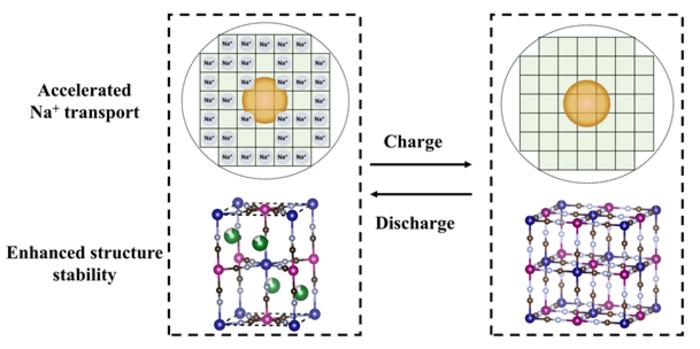This study is led by Prof. Yuliang Cao and Prof. Yongjin Fang (College of Chemistry and Molecular Sciences, Wuhan University). The experiments were performed by using ammonia etching on highly crystalline Na2NiFe(CN)6 (denoted as NaNiHCF) to activate the sodium storage sites and accelerate the Na+ transport.

Credit: ©Science China Press
This study is led by Prof. Yuliang Cao and Prof. Yongjin Fang (College of Chemistry and Molecular Sciences, Wuhan University). The experiments were performed by using ammonia etching on highly crystalline Na2NiFe(CN)6 (denoted as NaNiHCF) to activate the sodium storage sites and accelerate the Na+ transport.
Fe(CN)6 vacancies and the water molecules in the lattice, which are concomitant during the synthesis, however, lead to poor electrochemical performance. Hence, optimizing the crystal structures of PBAs to boost their electrochemical performance is currently a hot spot in the research on PBAs. It is undisputed that the concomitant water molecules and Fe(CN)6 vacancies during the synthesis have a great influence on the electrochemical performance of PBAs. Besides, the morphology also affects the electrochemical properties due to changed surface area and Na+ diffusion routes, but few work pays attention to the morphology control. Etching is an effective method to tailor the morphology of PBAs. Nevertheless, the systematic study of the etching on the morphologies of PBAs and their structure-composition-performance properties have been rarely reported.
Herein, the ammonia etching on highly crystalline Na2NiFe(CN)6 (denoted as NaNiHCF) to activate the sodium storage sites and accelerate the Na+ transport. The ammonia etching leads to a progressive smoothing of the corners of the cubes, transforming them from standard cubes to dice shape particles. This augmented surface area facilitates improved contact between the electrolyte and electrode and reduces the diffusion paths for Na+ transmission. As a result, a great number of Na+ ions can be deintercalated from the PBAs skeleton, thereby improving the specific capacity. The sample etched for 3 h (NaNiHCF-3) exhibited the highest discharge specific capacity increasing from 76.8 mAh g-1 of NaNiHCF-0 precursor to 83.5 mAh g-1, and excellent cycling stability with a superior capacity retention of 94 % after 1000 cycles at 1 C. The ammonia etching proves to be an effective approach in enhancing the electrochemical performance of PBAs by regulating the morphology of NaNiHCF.
See the article:
Boosting the sodium storage performance of Prussian blue analogues via effective etching
https://link.springer.com/article/10.1007/s11426-023-1824-3
Journal
Science China Chemistry
DOI
10.1007/s11426-023-1824-3




